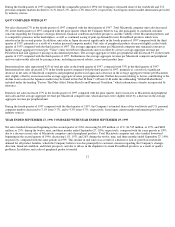Apple 1997 Annual Report Download - page 23
Download and view the complete annual report
Please find page 23 of the 1997 Apple annual report below. You can navigate through the pages in the report by either clicking on the pages listed below, or by using the keyword search tool below to find specific information within the annual report.The Company's future consolidated operating results and financial condition may be affected by overall demand for personal computers and
general customer preferences for one platform over another or one set of product features over another.
The Company is currently the primary maker of hardware that uses the Mac OS. The Mac OS has a minority market share in the personal
computer market, which is dominated by makers of computers that run the Microsoft Windows 95 and Windows NT operating systems. The
Company believes that the Mac OS, with its perceived advantages over Windows, and the general reluctance of the Macintosh installed base to
incur the costs of switching platforms, have been driving forces behind sales of the Company's personal computer hardware for the past several
years. Recent innovations in the Windows platform, including those included in Windows 95 and Windows NT, or those expected to be
included in a new version of Windows to be introduced in 1998, have added features to the Windows platform that make the differences
between the Mac OS and Microsoft's Windows operating systems less significant. The Company is currently taking and will continue to take
steps to respond to the competitive pressures being placed on its personal computer sales as a result of the recent innovations in the Windows
platform. The Company's future operating results and financial condition will be substantially dependent on its ability to maintain continuing
improvements of the Macintosh platform in order to maintain perceived functional advantages over competing platforms.
The Company had previously entered into agreements to license its Mac OS to other personal computer vendors (the "Clone Vendors") as part
of an effort to increase the installed base for the Macintosh platform. The Company recently determined that the benefits of licensing the Mac
OS to the Clone Vendors under these agreements were more than offset by the impact and costs of the licensing program. As a result, the
Company agreed to acquire certain assets, including the license to distribute the Mac OS, of PCC, a Clone Vendor, and has no plans to renew
its other Mac OS licensing agreements. Although the Company believes that this winding down of its licensing program will help reduce the
adverse impact of the licensing program on the Company's sales, market share and gross margins, there can be no assurance that this will occur.
In addition, there can be no assurance that this winding down of the licensing program will not result in the availability of fewer application
software titles for the Mac OS, which may result in a decrease to the Company's sales, market share and gross margins.
As a supplemental means of addressing the competition from Windows and other platforms, the Company had previously devoted substantial
resources toward developing personal computer products capable of running application software designed for the Windows operating systems.
These products include an add-on card containing a Pentium or 586-class microprocessor that enables users to run applications concurrently
that require the Mac OS, Windows 3.1 or Windows 95 operating systems. The Company plans to transition the cross-platform business to
third-parties during 1998. There can be no assurance that this transition will be successful.
The Company, International Business Machines Corporation and Motorola, Inc. had agreed upon and announced the availability of
specifications for a PowerPC microprocessor-based hardware platform (the "Platform"). These specifications defined a "unified" personal
computer architecture that would have given the Clone Vendors broad access to the Power Macintosh platform and would have utilized
standard industry components. The Company had intended to license the Mac OS to manufacturers of the Platform. However, the Company has
decided it will no longer support the Platform based upon its decision to wind down its Mac OS licensing program, and because of little
industry support for the Platform. The decision not to further develop this Platform may affect the Company's ability to increase the installed
base for the Macintosh platform.
Several competitors of the Company have either targeted or announced their intention to target certain of the Company's key market segments,
including education and publishing. Many of these companies have greater financial, marketing, manufacturing, and technological resources
than the Company.
20
























